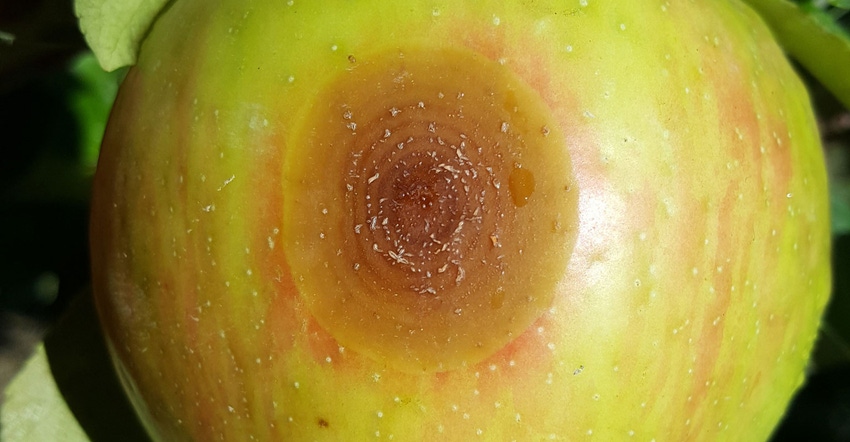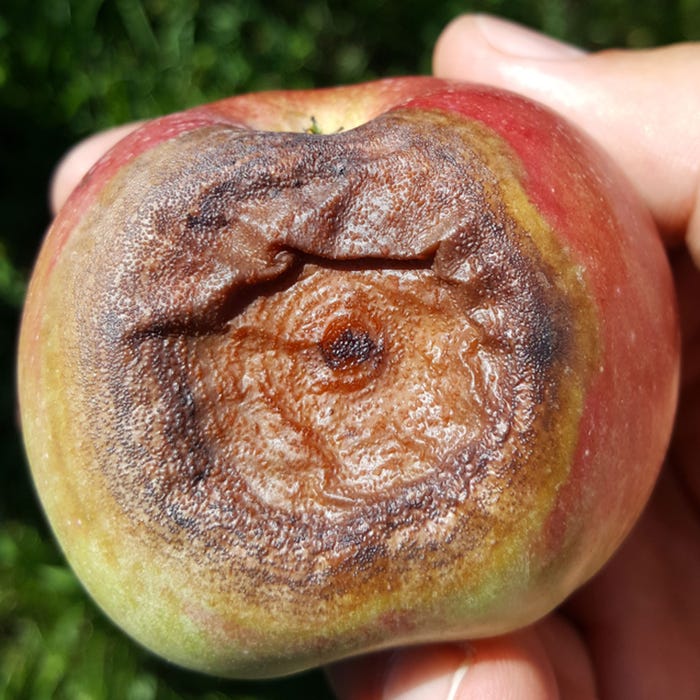July 15, 2020

Cornell University plant pathologists have identified a new fungal pathogen that causes bitter rot disease in apples. In addition, a second related fungus known to cause rot disease in other fruits was found for the first time in apples.
"We were shocked by what we found, just dumbfounded," says Srdjan Acimovic, a senior Extension associate at the Hudson Valley Research Laboratory, part of Cornell AgriTech, and the paper’s senior author. "We found these two species, one that has never been described before and one that has been described before but never on this host."
Both pathogens belong to the genus Colletotrichum, which contains 189 species of fungi that cause devastating rot diseases in a wide variety of fruit crops, including banana, strawberry, citrus, avocado, papaya, mango and apple.
If protective practices are not applied in a timely manner, apple losses from bitter rot can average up to 25% per year, with reports of some organic farms losing up to 100% of their crop. Bitter rot also accounts for up to 5% additional loss of marketable fruit in storage post-harvest.
The dominant species found was C. fioriniae, followed by C. chrysophilum, which is found in other fruits but for the first time has been found in apples. The newly discovered C. noveboracense is named after New York state in Latin.
"This indicates that there is higher diversity of pathogenic species in the genus Colletotrichum that cause bitter rot in New York," he wrote in a follow-up email.
Colletotrichum fungi that infect apple fruit can largely be divided in two main groups: The C. gloeosporioides complex that thrives in warmer growing regions, and the C. acutatum complex that is more frequently reported in cooler growing regions. Based on the group they belong to, species can react differently to fungicides. For this reason, identifying and characterizing the fungi is important for bitter rot management.
C. fioriniae belongs to the cooler C. acutatum species complex while C. chrysophilum and C. noveboracense belong to the warmer C. gloeosporioides species complex.
“When we know which species are dominant in our area, we know how environmental conditions will affect them and which control method is best in an orchard,” says study first author Fatemeh Khodadadi, a postdoctoral researcher in Acimovic's lab.
How they were found
Acimovic says that the finding was made in 2019 from a large collection of analyzed fungal isolates collected in 2017 and 2018.
"We sampled infected apples from orchards in New York that were mildly to severely affected with bitter rot disease during 2017 and 2018, which is primarily in the Hudson River Valley region and on Long Island," Acimovic says. "There seems to be a lower incidence of this disease north of the city of Albany, but this varies from year to year and there are isolated reports of bitter rot disease being present in the past in some New York orchards in the Lake Champlain Valley and near Lake Ontario.
"The incidence of this disease depends not only from the local- and year-specific weather conditions, but also from the protective spray applications of fungicides that growers use over the late spring and summer to protect the fresh apple crop."
He says that the range of species found aligns well with the Hudson River Valley climate zone, which has a hot-summer humid continental climate. The rest of the state has a warm-summer continental climate type except for Long Island, which has a humid subtropical climate. Both climates are favorable for bitter rot development in apples and pears.
Impact of climate change?
Acimovic says that more research is needed to expand the sampling of infected fruit to western New York orchards where bitter rot is more of an intermittent problem but has been detected more in apple storages just before packing.
More work is needed to explain why this is the case, he says, and whether growers should expect more frequent years with higher apple bitter rot disease, especially with the rising temperatures and more intense precipitation associated with climate change.
In the future, the researchers plan to work with other plant pathologists and apple breeders to identify possible genes that confer natural resistance to Colletotrichum fungi that may be bred into apple cultivars.
 BITTER BULLSEYE: Left unchecked, the lesions darken to brown and expand to develop a distinctive bullseye pattern.
BITTER BULLSEYE: Left unchecked, the lesions darken to brown and expand to develop a distinctive bullseye pattern.

"We have done the first step in identifying the control options that growers could use," Acimovic says. "In the paper we present how susceptible these three Colletotrichum species are to different fungicides we selected so that we can characterize their response range to them. However, this test on fungicides we did is done in the lab, by mixing the fungal growth medium with the fungicides, which does not include the plant and hence needs to be confirmed in the orchard with at least two years of consistent control data.
"We currently have a funded New York Farm Viability Institute grant project that is evaluating 14 different spray programs with new and classic fungicides registered on apple with the goal to generate data on how effective they are in controlling these pathogens in the orchard."
The study, "Identification and Characterization of Colletotrichum Species Causing Apple Bitter Rot in New York and Description of C. noveboracense sp. nov.," was published July 6 in the journal Scientific Reports.
Source: Cornell University, which is solely responsible for the information provided and is wholly owned by the source. Informa Business Media and all its subsidiaries are not responsible for any of the content contained in this information asset.
You May Also Like




